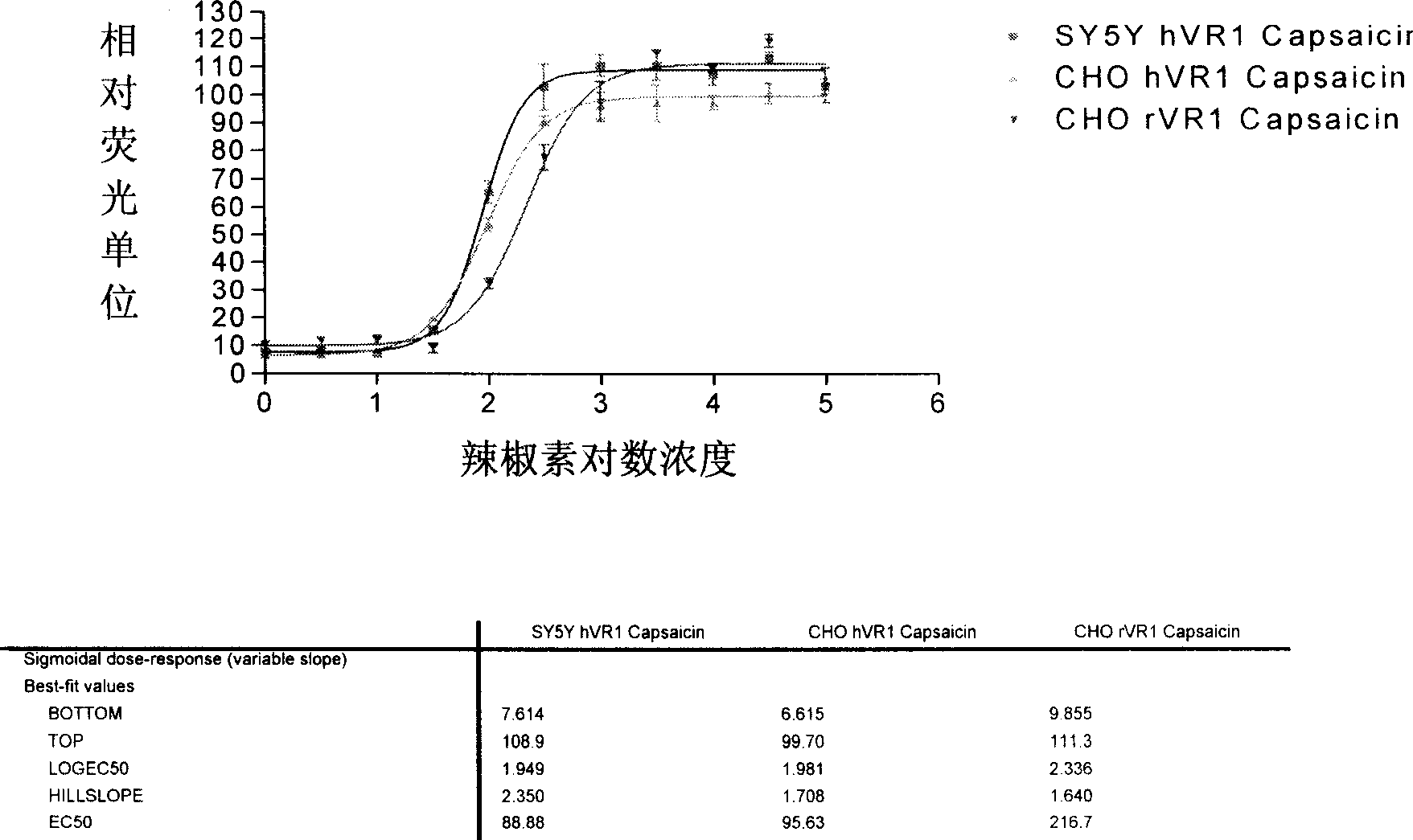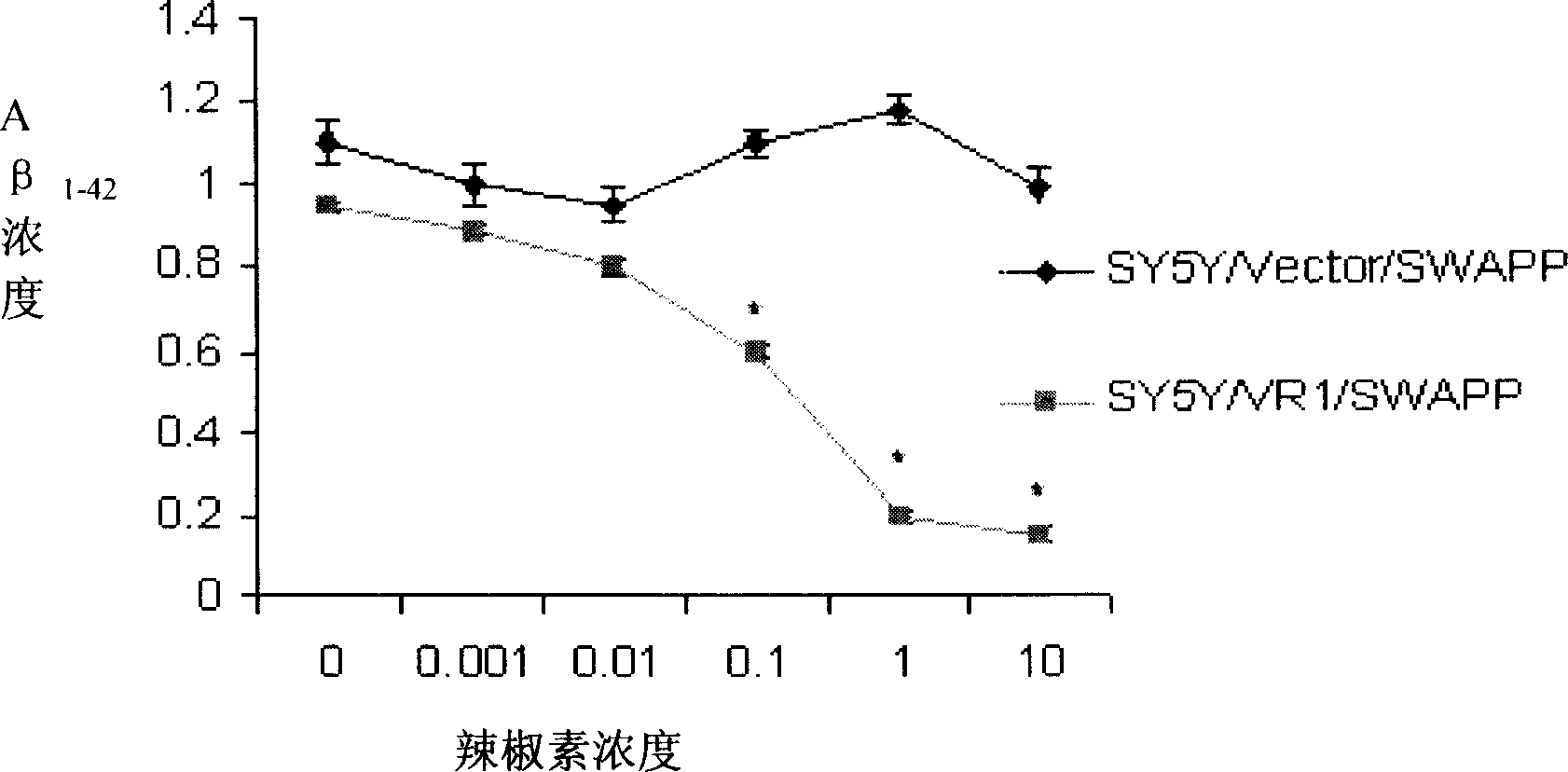Use of vanillin receptor agonist in preparation of product for resisting Alzheimer disease
A technology for Alzheimer's disease and receptor agonists, which is applied in the field of vanillin receptor agonists and vanillin receptor agonists for the preparation of anti-Alzheimer's disease products, which can solve the effects of liver function and transaminase index , No problems such as application reports of vanillin receptor agonist anti-Alzheimer's disease products, restrictions on market development, etc. have been found
- Summary
- Abstract
- Description
- Claims
- Application Information
AI Technical Summary
Problems solved by technology
Method used
Image
Examples
Embodiment 1
[0292] Embodiment 1, FLIPR analytical method measures the efficacy of capsaicin on VR1
[0293] First, in SHSY5Y cells stably transfected with TRPV1 and APP695swe (SY5Y / VR1 / SWAPP), an important established human neuroblastoma cell line, fluorescence imaging microplate assay (FLIPR) was used to evaluate the effect of capsaicin on the Effectiveness of VR1 (EC50 value, figure 1 ). Capsaicin showed dose-dependent activity in SY5Y-hVR1 and CHO / hVR1 / rVR1 cell lines.
[0294] like figure 1 (In SY5Y / VR1 / SWAPP cells, using FLIPR assay to measure capsaicin activity), the blue, green, and red curves represent the response of SY5Y-hVR1, CHO / hVR1 and CHO / rVR1 cells to different concentrations of capsaicin, respectively. Reaction. CHO / hVR1 and CHO / rVR1 cell lines are used here as controls. The table shows the EC50 values of capsaicin in the three cell lines calculated from the data measured in the dose-dependent experiments described above. FLIPR assays were performed on 96-well PLI...
Embodiment 2
[0295] Embodiment 2, detect capsaicin on Aβ with ELISA 1-42 generated impact
[0296] The following sandwich ELISA (enzyme-linked immunolabeling assay) shows that capsaicin-induced VR1 channel activation leads to Aβ 1-42 generate reduction ( figure 2 : Detection of capsaicin on Aβ by ELISA 1-42 generated impact). After transfecting SY5Y / VR1 / SWAPP cells with RD for 48 hr, the cells were washed twice with PBS, and after adding fresh medium, different concentrations of capsaicin (eg, capsaicin) were added to the medium. figure 2 shown). Two hours later, the culture medium was collected, and Aβ was detected by ELISA; the cells were collected for the subsequent determination of PKCε kinase activity. like figure 2 shown that capsaicin at a concentration of 0.1 μM or higher greatly reduced Aβ 1-42 generation.
[0297] Quantification of Aβ and Aβ using a sandwich ELISA 1-42 . Briefly described below, with sampling buffer (0.6% BSA, 8 mM Na 2 HPO 4 *7H 2 O, 1.5mM NaH 2...
Embodiment 3
[0298] Example 3. Western blot quantitative determination of PKCε kinase activity
[0299] Subsequent quantitative Western blot assays showed that activation of the VR1 channel resulted in increased PKCε kinase activity (see image 3 : Quantitative quantitative Western blot assay for PKCε kinase activity). Aβ in cell lysate 1-42 The marked decrease in PKCε kinase activity (PKCε is the predominant PKC isoform expressed in the SY5Y cell line) is consistent with phosphorescence-RDα quantitative western blot assay. like image 3 shown, capsaicin above 0.1 M significantly increased PKC kinase activity.
[0300] SY5Y / VR1 / SWAPP cells were transiently transfected with RDα, a unique Pan-PKC substrate expressing strain. PKCε kinase activity was determined by quantitative western blotting using an anti-phospho-RDα antibody. The resulting ink dots were analyzed by densitometry. Densitometric data were normalized with β-actin densitometry from parallel loaded blots.
PUM
| Property | Measurement | Unit |
|---|---|---|
| diameter | aaaaa | aaaaa |
| hardness | aaaaa | aaaaa |
Abstract
Description
Claims
Application Information
 Login to View More
Login to View More - R&D
- Intellectual Property
- Life Sciences
- Materials
- Tech Scout
- Unparalleled Data Quality
- Higher Quality Content
- 60% Fewer Hallucinations
Browse by: Latest US Patents, China's latest patents, Technical Efficacy Thesaurus, Application Domain, Technology Topic, Popular Technical Reports.
© 2025 PatSnap. All rights reserved.Legal|Privacy policy|Modern Slavery Act Transparency Statement|Sitemap|About US| Contact US: help@patsnap.com



